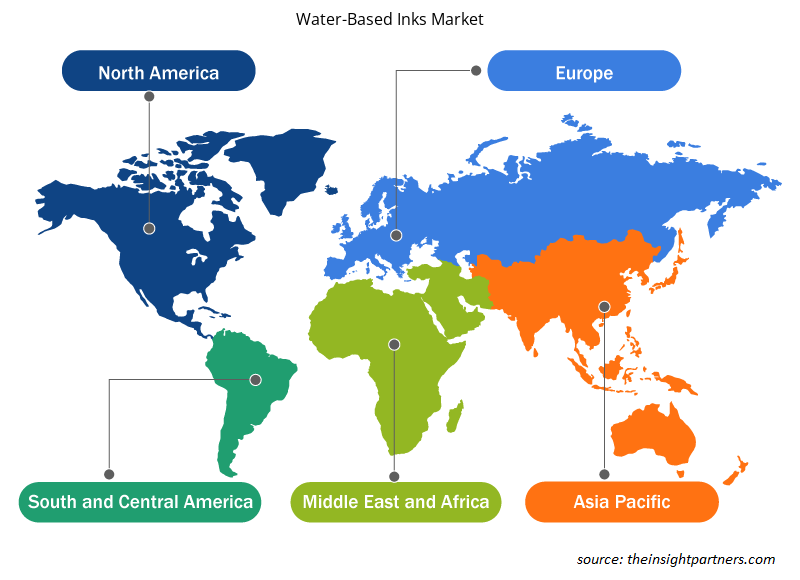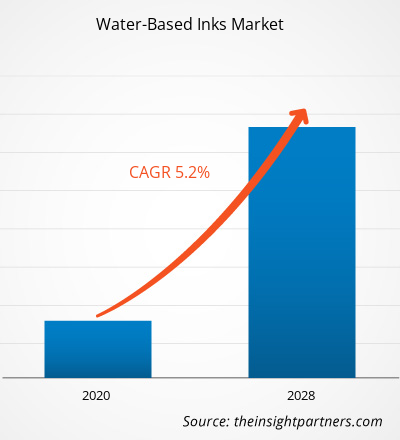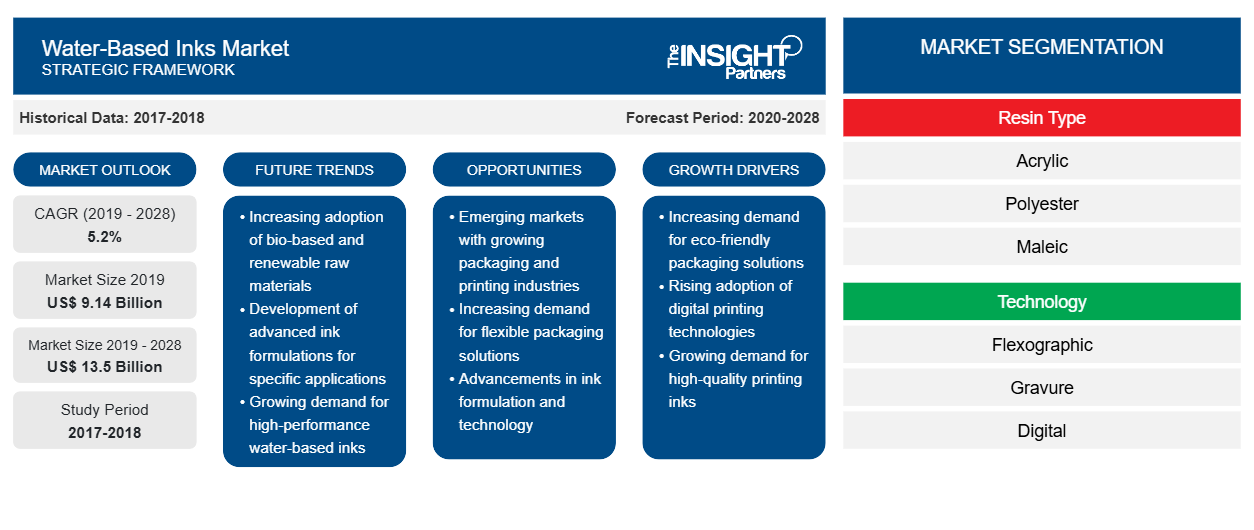Der Markt für wasserbasierte Tinten wurde im Jahr 2019 auf 9.141,20 Millionen US-Dollar geschätzt und soll bis 2028 13.496,39 Millionen US-Dollar erreichen; von 2020 bis 2028 wird mit einer durchschnittlichen jährlichen Wachstumsrate von 5,2 % gerechnet.
Wasserbasierte Tinte enthält Pigmente oder Farbstoffe in einer kolloidalen Suspension mit Wasser als Lösungsmittel. Während Wasser das primäre Lösungsmittel bei der Herstellung wasserbasierter Tinten ist, können die Tinten andere Co-Lösungsmittel enthalten, um die Zeit und die Hitze zu reduzieren, die zum Aushärten des Tintenfilms auf Stoff erforderlich sind. Wasserbasierte Tinten haben eine höhere Viskositätsstabilität auf der Presse, da Wasser langsam verdunstet. Die Nachfrage nach wasserbasierten Tinten hat aufgrund zunehmender Umwelt- und Sicherheitsbedenken, des Wachstums flexibler Verpackungen und der zunehmenden Nutzung im Siebdruck zugenommen.
Im Jahr 2019 hatte die Region Asien-Pazifik den größten Anteil am weltweiten Markt für wasserbasierte Tinten . Das Wachstum des Marktes für wasserbasierte Tinten in dieser Region ist in erster Linie auf die steigende Nachfrage aus Entwicklungsländern wie China und Indien zurückzuführen. Diese Länder verzeichnen ein enormes Wachstum in der Druck- und Verpackungsindustrie. Das kontinuierliche Wachstum in den Branchen Lebensmittel und Getränke, Pharma und Körperpflege erfordert hochwertige Verpackungs- und Etikettierprodukte. Wasserbasierte Druckfarben sind ein hervorragendes Tintensystem für den Papier- und Kartondruck. Sie haben einen besseren Glanz und eine bessere Farbe sowie ein gutes Oberflächenbild im Vergleich zu anderen Druckfarben auf saugfähigen Substraten wie Papier und Karton und bei langsamerem Druckauftrag. Wasserbasierte Tinte gibt viel weniger flüchtige organische Verbindungen (VOCs) ab, daher sind die Kosten im Zusammenhang mit der Schadstoffemission im Vergleich zu lösemittelbasierter Tinte viel geringer. All diese Vorteile haben die Einführung wasserbasierter Tinten in der Region Asien-Pazifik erhöht. Abgesehen davon dringen wasserbasierte Tinten tiefer in das Gewebe ein und können länger anhaltende Drucke mit tadellosen Details und viel klarer definierten, schärferen Kanten erzeugen. Dazu gehören Halbtöne und mehr, was sie zur perfekten Wahl für den Druck komplexer, detaillierter Designs macht. Die steigende Nachfrage nach wasserbasierten Tinten aus dem Textildruck in der Region Asien-Pazifik wird voraussichtlich die Nachfrage nach wasserbasierten Tinten im Prognosezeitraum ankurbeln.
Die anhaltende COVID-19-Pandemie hat den Wachstumsstatus der wasserbasierten Tintenindustrie drastisch verändert. Der Ausbruch hat die Betriebseffizienz beeinträchtigt und die Wertschöpfungsketten aufgrund der plötzlichen Schließung nationaler und internationaler Grenzen unterbrochen, was zu Umsatzverlusten und Schäden geführt hat. Die gestörte Wertschöpfungskette hat sich negativ auf die Rohstoffversorgung ausgewirkt. Da die Volkswirtschaften jedoch planen, ihre Betriebe wieder anzukurbeln, wird erwartet, dass die Nachfrage nach wasserbasierten Tinten in den kommenden Monaten weltweit steigen wird. Der Fokus auf Just-in-time-Produktion ist ein weiterer Faktor, der das Wachstum des Marktes für wasserbasierte Tinten behindert. Angesichts der prognostizierten zunehmenden Bedeutung von Nachhaltigkeit und Anwendungsdiversifizierung in Zeiten nach der Pandemie wird erwartet, dass die Nachfrage nach wasserbasierten Tinten enorme Sprünge machen wird. Mehrere Verbände wie die Association for Packaging and Processing (PMMI) sind daran beteiligt, die Auswirkungen der Pandemie auf die Druck- und Verpackungsindustrie genau zu beobachten und den betroffenen Parteien die notwendigen Möglichkeiten bereitzustellen. Daher ist zu erwarten, dass die wirksamen Maßnahmen dieser Verbände zur Unterstützung der Verpackungsindustrie, unterstützt durch positive Regierungsinitiativen, in den kommenden Jahren die Nachfrage nach wasserbasierten Tinten steigern werden. Darüber hinaus sind erhebliche Investitionen namhafter Unternehmen in die Entwicklung fortschrittlicher Produkte ein weiterer Faktor, der das Marktwachstum unterstützt.
Passen Sie diesen Bericht Ihren Anforderungen an
Sie erhalten kostenlose Anpassungen an jedem Bericht, einschließlich Teilen dieses Berichts oder einer Analyse auf Länderebene, eines Excel-Datenpakets sowie tolle Angebote und Rabatte für Start-ups und Universitäten.
-
Holen Sie sich die wichtigsten Markttrends aus diesem Bericht.Dieses KOSTENLOSE Beispiel umfasst eine Datenanalyse von Markttrends bis hin zu Schätzungen und Prognosen.
Markteinblicke
Hohe Nachfrage nach flexiblen Verpackungen
Flexible Verpackungen sind Verpackungsarten oder Verpackungsteile, die aus einer nicht starren Struktur bestehen und leicht in verschiedene Formen gebracht werden können. Diese Art der Verpackung ermöglicht einen besseren Transport der verpackten Waren und ermöglicht anpassbare Designs sowie eine längere Lebensdauer. Laut der Flexible Packaging Association gelten flexible Verpackungen als der zweitgrößte Wachstumsfaktor im Verpackungssegment in den USA, da sie etwa 19 % des Verpackungsmarktes des Landes ausmachten, der 2018 in den USA 170 Milliarden US-Dollar wert war. Die in flexiblen Verpackungen verwendeten Tinten tragen dazu bei, die grafische Gesamtdarstellung zu verbessern und die Qualität der aufgedruckten Bilder während Phasen wie Herstellung, Verpackung und Transport sowie zum Zeitpunkt der endgültigen Verwendung des Produkts aufrechtzuerhalten. Früher wurden anstelle von wasserbasierten Tinten häufig lösemittelbasierte Tinten verwendet, da letztere Nachteile mit sich brachten, wie z. B. niedrigere Druckgeschwindigkeiten, langsamere Wasserverdunstung, unsachgemäßer Benetzungsmechanismus und mangelhafte Bedruckbarkeit auf kritischen Substraten. Die Nachfrage nach wasserbasierten Tinten ist jedoch aufgrund des zunehmenden Fokus auf Nachhaltigkeit unaufhörlich gestiegen. Die Fortschritte bei Drucktechniken wie der Einsatz verbesserter Harze, besserer Tintenformulierungen und leistungsfähiger Druckgeräte haben den Druckherstellern geholfen, die Nachteile wasserbasierter Tinten zu überwinden. Diese Entwicklungen haben es den wasserbasierten Tinten ermöglicht, die Leistungsstandards für flexible Verpackungsmaterialien zu erfüllen. Marabu ist an der Produktion und Lieferung wasserbasierter Inkjet-Tinten beteiligt, die in flexiblen Verpackungen für Produkte der Lebensmittel- und Getränkeindustrie sowie der Konsumgüterindustrie wie Kartons, Spielzeug und digital bedruckten Tapeten verwendet werden.customizable designs and better life span. As per the Flexible Packaging Association, the flexible packaging is considered to be the second largest contributor to the growth of packaging segment in the US, as it garnered ~19% of the packaging market in the country, which was worth US$ 170 billion in US in 2018. The inks used in flexible packaging help enhance the overall graphic representation and maintain the quality of imprinted images during phases such as manufacturing, packaging, and transportation, as well as at the time of the final use of the product. Earlier, solvent-based inks were extensively in use instead of water-based inks, due to drawbacks associated with the latter, such as lower printing speeds, slower water evaporation, improper wetting mechanism, and imperfect printability on critical substrates. However, the demand for water-based inks has grown incessantly owing to increasing focus on sustainability. The advancements in printing techniques such as deployment of improved resins, better ink formulation, and high-performance printing equipment have helped printing manufacturers to overcome the drawbacks of water-based inks. These developments have enabled the water-based inks to meet the performance standards associated with flexible packaging materials. Marabu is involved in production and supply of water-based inkjet inks used in flexible packaging of the food & beverages industry products as well as the consumer goods industry products, such as cardboard boxes, toys, and digitally printed wallpapers.
Einblicke in den Harztyp
Basierend auf dem Harztyp ist der Markt für wasserbasierte Tinten in Acryl-, Polyester-, Maleinsäure- und andere Tinten unterteilt. Das Acrylsegment war 2019 mit dem größten Anteil Marktführer. Wasserbasierte Acrylfarbe besteht aus Pigmentpartikeln, die in einer Acrylpolymeremulsion dispergiert sind. Die Pigmente sind körnige Feststoffe, die der Farbe ihre Farbe verleihen. Sie werden zu winzigen Partikeln gemahlen und bleiben in der Farbe suspendiert. Diese Pigmente können entweder organisch, anorganisch, natürlich oder synthetisch sein. Das Bindemittel ist eine Substanz, die das Pigment an Ort und Stelle hält, nachdem die Tinte getrocknet ist.maleic, and others. The acrylic segment led the market with the largest share in 2019. Water-based acrylic paint is composed of pigment particles that are dispersed in an acrylic polymer emulsion. The pigments are granular solids that provide paint its color. They are milled into tiny particles and remain suspended in the paint. These pigments can either be organic, inorganic, natural, or synthetic. The binder is a substance that keeps the pigment in place after the ink dries..
Zu den wichtigsten Marktteilnehmern auf dem Markt für wasserbasierte Tinten gehören DIC Corporation; Flint Group; Hubergroup; Sakata Inx Corporation; Siegwerk Druckfarben AG & Co. KGaA; T&K TOKA Co. Ltd.; Toyo Ink SC Holdings Co., Ltd.; Fujifilm Holdings Corporation; American Inks & Technology; und Wikoff Color Corporation. Wichtige Marktteilnehmer verfolgen Strategien wie Fusionen und Übernahmen sowie Produkteinführungen, um ihre geografische Präsenz und Kundenbasis weltweit zu erweitern. DIC Corporation; Flint Group; Hubergroup; Sakata Inx Corporation; Siegwerk Druckfarben AG & Co. KGaA; T&K TOKA Co. Ltd.; Toyo Ink SC Holdings Co., Ltd.; Fujifilm Holdings Corporation; American Inks & Technology; and Wikoff Color Corporation. Major market players are adopting strategies such as mergers and acquisitions and product launches to expand their geographical presence and consumer base globally.
Bericht-Spotlights
- Fortschrittliche Branchentrends auf dem globalen Markt für wasserbasierte Tinten helfen den Akteuren bei der Entwicklung wirksamer langfristiger Strategien
- In Industrie- und Entwicklungsländern angewandte Strategien für Unternehmenswachstum
- Quantitative Analyse des globalen Marktes für wasserbasierte Tinten von 2019 bis 2028
- Schätzung der Nachfrage nach wasserbasierten Tinten in verschiedenen Branchen
- PEST-Analyse zur Veranschaulichung der Wirksamkeit der in der Branche tätigen Käufer und Lieferanten bei der Vorhersage des Marktwachstums
- Aktuelle Entwicklungen zum Verständnis des Wettbewerbsmarktszenarios und der Nachfrage nach wasserbasierten Tinten
- Markttrends und -aussichten in Verbindung mit Faktoren, die das Wachstum des Marktes für wasserbasierte Tinten vorantreiben und bremsen
- Entscheidungsprozess durch das Verständnis von Strategien, die das kommerzielle Interesse im Hinblick auf das Wachstum des globalen Marktes für wasserbasierte Tinten untermauern
- Marktgröße für wasserbasierte Tinte an verschiedenen Marktknoten
- Detaillierte Übersicht und Segmentierung des globalen Marktes für wasserbasierte Tinten sowie seine Dynamik in der Branche
- Marktgröße wasserbasierter Tinten in verschiedenen Regionen mit vielversprechenden Wachstumschancen
Regionale Einblicke in den Markt für wasserbasierte Tinten
Die regionalen Trends und Faktoren, die den Markt für wasserbasierte Tinten während des gesamten Prognosezeitraums beeinflussen, wurden von den Analysten von Insight Partners ausführlich erläutert. In diesem Abschnitt werden auch Marktsegmente und Geografie für wasserbasierte Tinten in Nordamerika, Europa, im asiatisch-pazifischen Raum, im Nahen Osten und Afrika sowie in Süd- und Mittelamerika erörtert.

- Erhalten Sie regionale Daten zum Markt für wasserbasierte Tinten
Umfang des Marktberichts über wasserbasierte Tinten
| Berichtsattribut | Details |
|---|---|
| Marktgröße im Jahr 2019 | 9,14 Milliarden US-Dollar |
| Marktgröße bis 2028 | 13,5 Milliarden US-Dollar |
| Globale CAGR (2019 - 2028) | 5,2 % |
| Historische Daten | 2017-2018 |
| Prognosezeitraum | 2020–2028 |
| Abgedeckte Segmente |
Nach Harztyp
|
| Abgedeckte Regionen und Länder |
Nordamerika
|
| Marktführer und wichtige Unternehmensprofile |
|
Dichte der Marktteilnehmer für wasserbasierte Tinten: Die Auswirkungen auf die Geschäftsdynamik verstehen
Der Markt für wasserbasierte Tinten wächst rasant, angetrieben durch die steigende Nachfrage der Endverbraucher aufgrund von Faktoren wie sich entwickelnden Verbraucherpräferenzen, technologischen Fortschritten und einem größeren Bewusstsein für die Vorteile des Produkts. Mit steigender Nachfrage erweitern Unternehmen ihr Angebot, entwickeln Innovationen, um die Bedürfnisse der Verbraucher zu erfüllen, und nutzen neue Trends, was das Marktwachstum weiter ankurbelt.
Die Marktteilnehmerdichte bezieht sich auf die Verteilung der Firmen oder Unternehmen, die in einem bestimmten Markt oder einer bestimmten Branche tätig sind. Sie gibt an, wie viele Wettbewerber (Marktteilnehmer) in einem bestimmten Marktraum im Verhältnis zu seiner Größe oder seinem gesamten Marktwert präsent sind.
Die wichtigsten auf dem Markt für wasserbasierte Tinten tätigen Unternehmen sind:
- DIC Corporation
- Flint-Gruppe
- Hubergroup
- Sakata Inx Corporation
- Siegwerk Druckfarben AG & Co. KGaA
Haftungsausschluss : Die oben aufgeführten Unternehmen sind nicht in einer bestimmten Reihenfolge aufgeführt.

- Überblick über die wichtigsten Akteure auf dem Markt für wasserbasierte Tinten
Markt für wasserbasierte Tinten nach Harztyp
- Acryl
- Polyester
- Maleinsäure
- Sonstiges
Markt für wasserbasierte Tinten nach Technologie
- Flexodruck
- Tiefdruck
- Digitales
- Sonstiges
Markt für wasserbasierte Tinten nach Anwendung
- Verpackung
- Veröffentlichung
- Tags und Labels
- Sonstiges
Firmenprofile
- DIC Corporation
- Flint-Gruppe
- Hubergroup
- Sakata Inx Corporation
- Siegwerk Druckfarben AG & Co. KGaA
- T&K TOKA Co. Ltd.
- Toyo Ink SC Holdings Co., Ltd.
- Fujifilm Holdings Corporation
- Amerikanische Tinten und Technologie
- Wikoff Color Corporation
- Historische Analyse (2 Jahre), Basisjahr, Prognose (7 Jahre) mit CAGR
- PEST- und SWOT-Analyse
- Marktgröße Wert/Volumen – Global, Regional, Land
- Branchen- und Wettbewerbslandschaft
- Excel-Datensatz
Aktuelle Berichte
Erfahrungsberichte
Grund zum Kauf
- Fundierte Entscheidungsfindung
- Marktdynamik verstehen
- Wettbewerbsanalyse
- Kundeneinblicke
- Marktprognosen
- Risikominimierung
- Strategische Planung
- Investitionsbegründung
- Identifizierung neuer Märkte
- Verbesserung von Marketingstrategien
- Steigerung der Betriebseffizienz
- Anpassung an regulatorische Trends























 Kostenlose Probe anfordern für - Markt für wasserbasierte Tinten
Kostenlose Probe anfordern für - Markt für wasserbasierte Tinten